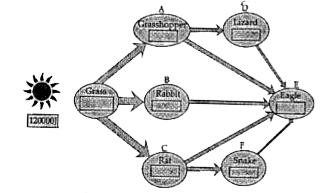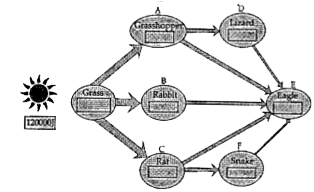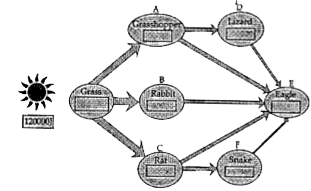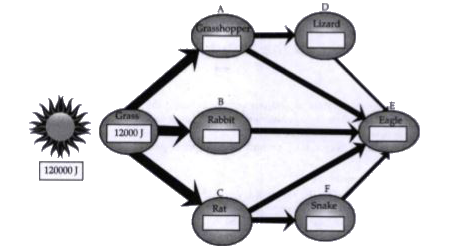Assume that the green plants in an ecosystem produce 1000 grams of dry mass per square meter per year and there is an efficiency of 10 percent in each transfer of energy from one trophic level to the next. How many total grams of dry mass will be produced by the tertiary consumers per square meter per year?
100
10
1
0.1
The correct Answer is:C
Similar Questions
Food chains and the energy flow within an ecosystem provide an important understanding of contingencies and mutual dependencies of organisms. The given below flow chart depicts the energy flow within some members of a grassland ecosystem. The grass in the below ecosystem transducer 120,000 J of sunlight and fixes it into 12,000 J of energy. It is established that 90% of the energy of one trophic level is not passed to the next trophic level. Further assume that the energy transferred from one trophic level to the next is equally shared among the different organisms at that trophic level.

Which organism acts as both the secondary consumer and the tertiary consumer?
View SolutionFood chains and the energy flow within an ecosystem provide an important understanding of contingencies and mutual dependencies of organisms. The given below flow chart depicts the energy flow within some members of a grassland ecosystem. The grass in the below ecosystem transducer 120,000 J of sunlight and fixes it into 12,000 J of energy. It is established that 90% of the energy of one trophic level is not passed to the next trophic level. Further assume that the energy transferred from one trophic level to the next is equally shared among the different organisms at that trophic level.

In the food web depicted above, identify the most energy efficient link for tertiary consumer.
View Solution
Knowledge Check
A company produces on an average 4000 items per month for the first 3 months. How many items it must produce on an average per month over the next 9 months, to average 4375 items per month over the whole? (a) 4500 (b) 4600 (c) 4680 (d) 4710
A4500B4600C4680D4710A house has an old gas furnace that is only 70% efficient . This means that only 70% of the heat produced by the gas goes into heating the house , while 30% of the least is lost . There is a constant charge per unit of gas , and the owner's gas bill is $1,200 per year .
The owner is considering replacing the furnace with a new one that is 90 percent energy efficient . To the nearest dollar , what would the gas bill be per year, assuming that the same amount of heat is required for the house ?A896B901C933D947
Food chains and the energy flow within an ecosystem provide an important understanding of contingencies and mutual dependencies of organisms. The given below flow chart depicts the energy flow within some members of a grassland ecosystem. The grass in the below ecosystem transducer 120,000 J of sunlight and fixes it into 12,000 J of energy. It is established that 90% of the energy of one trophic level is not passed to the next trophic level. Further assume that the energy transferred from one trophic level to the next is equally shared among the different organisms at that trophic level.

How many food chains are present in the food web depicted above?
View SolutionRead the given passage and answer the following questions :
Food chains and the energy flow within an ecosystem provide an important understanding of contingencies and mutual dependencies of organisms. The flow chart given below, depicts the energy flow within some members of a grassland ecosystem. The grass in the below ecosystem transduces 120,000 J of sunlight and fixes it into 12,000 J of energy. It is established that 90% of the energy of one trophic level is not passed to the next trophic level. Further assume that the energy transferred from one trophic level to the next is equally shared among the different organisms at that trophic level. Based on the information given and your knowledge, answer the following questions.

The first trophic level in a food chain is always a green plant. Why?
View SolutionRadium has atomic weight 226 and half life of 1600 years. The number of disintegrations produced per second from one gram is
View SolutionSuppose India had a target of producing by 2020 AD, 200,000 MW of electric power, ten per cent of which was to be obtained from nuclear power plants. Suppose we are given that, on an average, the efficiency of utilisation (i.e, conversion to electric energy) of thermal energy produced in a reactor was 25%. How much amount of fissionable uranium would our country need per year by 2020 ? Take the heat energy per fission of 235U to be about 200 MeV.
View SolutionSuppose India has a target of producing by 2020 A.D., 2×105MW of electric power, ten percent of which is to be obtained form nuclear power plants. Suppose we are given that on an average, the efficiency of utilization (i.e., conservation to electrical energy) of thermal energy produced in a reactor is 25%. How much amount of fissionable uranium will our country need per year? Take the heat energy per fission U235 to be about 200MeV.
View SolutionSuppose India has a target of producing by 2020AD,200,000MW of electric power, ten percent of which was to be obtained from nuclear power plants. Suppose we are given that, on an avedrage, the efficiency of utilization(i.e conversion to electric energy) of thermal energy produced in a reactor was 25%. How much amount of fissionable uranium would our country need per year by 2020? Take the heat energy per fission of .235U to be about 200MeV.
View Solution
